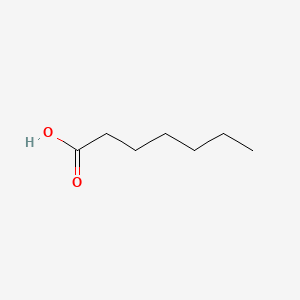| MeSH term | MeSH ID | Detail |
|---|---|---|
| Olfaction Disorders | D000857 | 17 associated lipids |
| Byssinosis | D002095 | 11 associated lipids |
| Mitochondrial Diseases | D028361 | 25 associated lipids |
HEPTANOIC ACID
HEPTANOIC ACID is a lipid of Fatty Acyls (FA) class. Heptanoic acid is associated with abnormalities such as Dehydration. The involved functions are known as Process, Anabolism, inhibitors, Oxidation and fatty acid oxidation. The related lipids are Heptanoates and undecanoic acid.
Cross Reference
Introduction
To understand associated biological information of HEPTANOIC ACID, we collected biological information of abnormalities, associated pathways, cellular/molecular locations, biological functions, related genes/proteins, lipids and common seen animal/experimental models with organized paragraphs from literatures.
What diseases are associated with HEPTANOIC ACID?
HEPTANOIC ACID is suspected in Dehydration and other diseases in descending order of the highest number of associated sentences.
Related references are mostly published in these journals:
| Disease | Cross reference | Weighted score | Related literature |
|---|
Possible diseases from mapped MeSH terms on references
We collected disease MeSH terms mapped to the references associated with HEPTANOIC ACID
PubChem Associated disorders and diseases
What pathways are associated with HEPTANOIC ACID
There are no associated biomedical information in the current reference collection.
PubChem Biomolecular Interactions and Pathways
Link to PubChem Biomolecular Interactions and PathwaysWhat cellular locations are associated with HEPTANOIC ACID?
There are no associated biomedical information in the current reference collection.
What functions are associated with HEPTANOIC ACID?
Related references are published most in these journals:
| Function | Cross reference | Weighted score | Related literatures |
|---|
What lipids are associated with HEPTANOIC ACID?
Related references are published most in these journals:
| Lipid concept | Cross reference | Weighted score | Related literatures |
|---|
What genes are associated with HEPTANOIC ACID?
There are no associated biomedical information in the current reference collection.
What common seen animal models are associated with HEPTANOIC ACID?
There are no associated biomedical information in the current reference collection.
NCBI Entrez Crosslinks
All references with HEPTANOIC ACID
Download all related citations| Authors | Title | Published | Journal | PubMed Link |
|---|---|---|---|---|
| Fiume MM et al. | Safety assessment of stearyl heptanoate and related stearyl alkanoates as used in cosmetics. | Int. J. Toxicol. | pmid:23064772 | |
| Tempel GE et al. | Improvement in organ blood flow by inhibition of thromboxane synthetase during experimental endotoxic shock in the rat. | 1986 May-Jun | J. Cardiovasc. Pharmacol. | pmid:2425166 |
| Tonosaki K and Shibuya T | Olfactory receptor cell responses of pigeon to some odors. | 1985 | Comp Biochem Physiol A Comp Physiol | pmid:2864176 |
| Gagliardo A and Teyssèdre A | Interhemispheric transfer of olfactory information in homing pigeon. | 1988 | Behav. Brain Res. | pmid:3358853 |
| Royet JP et al. | Specificity of spatial patterns of glomerular activation in the mouse olfactory bulb: computer-assisted image analysis of 2-deoxyglucose autoradiograms. | 1987 | Brain Res. | pmid:3620970 |
| Inokuchi A et al. | Olfactory evoked potentials in the rat. | 1986 | Laryngoscope | pmid:3762286 |
| Guzmán A et al. | Hypoglycemic activity in male rats of bicyclo (3, 1, 0) hexane-6-carboxylic acid derivatives. | 1985 Oct-Dec | Arch Invest Med (Mex) | pmid:3842921 |
| Mundie TG and Ainsworth SK | Byssinosis: thromboxane release from human platelets by cotton dust and bract extracts. | 1985 May-Jun | Arch. Environ. Health | pmid:4026387 |
| Marovitz WF and Khan KM | Scanning electron microscopic appearance of rat otocyst of the twelfth postcoital day: elaboration of a method. | 1977 Jan-Feb | Ann Otol Rhinol Laryngol Suppl | pmid:402880 |
| Liao LL and Richardson KE | The inhibition of oxalate biosynthesis in isolated perfused rat liver by DL-phenyllactate and n-heptanoate. | 1973 | Arch. Biochem. Biophys. | pmid:4689788 |
